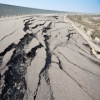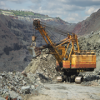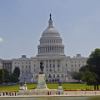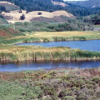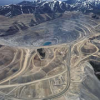AGI policy news briefs summarize geoscience policy activities and related events in Washington, D.C. as part of an effort to keep AGI member societies and other audiences informed about relevant federal policy and legislative updates.
To search for news briefs for a specific Monthly Review digest, enter the year and month of the Monthly Review in the search fields below.
Please note that as of April 2019, the publication of news briefs and the monthly review has been suspended. Policy news from April 2019 back to 2010 is available below; to browse Monthly Reviews from 1996 through 2010, please visit the Monthly Review Archive.
One month after the Oklahoma Corporation Commission (OCC) directed 27 oil and gas wastewater disposal wells to end wastewater injections, a magnitude-5.1 earthquake has shaken Fairview, Oklahoma.
The U.S. Government Accountability Office (GAO) has published a report detailing how the Department of Defense (DOD) can better manage supply chain risks for critical rare earth minerals and materials (rare earths).
Congressman Jared Huffman (D-CA) introduced new legislation, along with 16 democratic co-sponsors, that would prohibit new drilling leases in the Outer Continental Shelf (OCS) and new coal leases on federal land.
On February 9, President Obama announced his final federal budget request for fiscal year (FY) 2017.
The House Committee on Science, Space, and Technology, Subcommittee on Research and Technology, held a hearing to discuss recommendations for management reform at the National Science Foundation (NSF).
A list of notices from the federal register for January 2016 from agencies including the Department of the Interior, USGS, NOAA, NASA, and more.
The Bureau of Land Management is proposing an update to the 30-year-old regulations for oil and gas operations on federal and Native American lands.
Oklahoma experienced a 50 percent increase in earthquakes magnitude-3 or greater last year—up from 585 in 2014 to 881 in 2015.
This January, President Obama delivered his final State of the Union Address to Congress.
According to a new study published in the Proceedings of the National Academy of Sciences this January, growth rings on rocks may tell us about weather patterns from thousands of years ago.
The Department of Energy (DOE) is launching an initiative to find a long-term solution for dealing with U.S. radioactive waste and spent nuclear fuel.
In response to an EPA study on hydraulic fracturing, the agency’s Science Advisory Board (SAB), which provides independent scientific advice to the EPA, has submitted a critical draft letter expressing their concerns with the report’s findings.
Rep. Raúl Grijalva (D-AZ) has introduced a bill that would direct the Department of the Interior (DOI) to create environmentally responsible regulations for reopening abandoned mines.
The price of oil fell to $38 per barrel in December 2015, leading to massive cuts in the industry’s budget and workforce.
On December 18, Congress passed an omnibus spending bill providing funding for the federal government through September 30, 2016.
The Senate has finally confirmed Dr. Suzette M. Kimball as Director of the U.S. Geological Survey (USGS).
On December 14, the House Subcommittee on Energy and Mineral Resources held a field hearing at an unconventional location, the underground classroom of the Edgar Mine at the Colorado School of Mines Experimental Mine in Idaho Springs, Colorado.
In a bipartisan letter addressed to the Bureau of Ocean Energy Management, Reps. Mark Sanford (R-SC) and Bobby Scott (D-VA) called for a halt in seismic testing on the outer continental shelf of the Atlantic Ocean.
Senator Bernie Sanders (I-VT) introduced two bills on investment in renewable energy tax credits and the state of jobs in the coal mining industry.
The Microbead-Free Waters Act (H.R. 1321) passed the House by a voice-vote on December 7, 2015. H.R. 1321 attempts to lower the negative environmental impacts that synthetic microbeads have on water pollution.
A list of notices from the federal register for November 2015 from agencies including the Department of the Interior, USGS, NOAA, NASA, and more.
The fiscal year (FY) 2016 National Defense Authorization Act (S. 1356), which normally focuses on the Department of Defense, included provisions supporting scientific research and collaboration among all federal science agencies.
H.R. 8, or the North American Energy Security and Infrastructure Act, passed the House on December 3, 2015.
Rep. Rick Crawford (R-AR) introduced the Groundwater Conservation Incentive Act (H.R. 4175) on December 3, which would amend the Internal Revenue Code of 1986.
The Department of Energy (DOE) Geothermal Technologies Office announced funding for a new program to explore the potential for recovering rare earth elements and other critical materials from dissolved geothermal fluids and high temperature brines.
The U.S. Global Change Research Program (USGCRP) released a triennial update to their 2012-2021 strategic plan this December.
The U.S. Commercial Space Launch Competitiveness Act (H.R. 2262) passed the Senate and House of Representatives and was signed into law by the President on November 25.
The Obama Administration released an executive order today outlining new greenhouse gas emissions targets for federal agencies for 2016.
The Senate Energy and Natural Resources Committee approved the Bipartisan Sportsmen’s Act (S. 556) on November 19.
Senators Michael Bennet (D-CO) and Rob Portman (R-OH) introduced legislation on November 19, 2015 that allows industrial facilities to finance the purchase and installation of carbon capture and storage (CCS) equipment.
Senator Tom Udall (D-NM) released a bill known as the Accelerating Technology Transfer to Advance Innovation for the Nation (ATTAIN) Act (S.___) on November 17.
The Critical Infrastructure Protection Act of 2015 (H.R. 1073) passed the House on November 17; the bill aims to prepare the nation in the event of an electromagnetic pulse (EMP).
The Department of Energy, in collaboration with the National League of Cities and the National Association of State Energy Officials, is launching a data-sharing program aimed at enhancing energy efficiency in buildings and lowering costs throughout the U.S.
The Wildland Fire Science and Technology Task Force, chartered under the National Science and Technology Council’s Subcommittee on Disaster Reduction, released a report in conjunction with the Fire Chiefs’ White House Roundtable recommending better communication between federal agencies that gather research on wildfire mitigation and response and the people that use the research to inform policy makers.
President Obama announced his rejection of the construction of TransCanada Corporation’s Keystone XL pipeline this November.
Senator Tom Udall (D-NM) and other Democratic senators introduced legislation requiring mining companies to pay royalties for abandoned hardrock mine cleanup efforts.
The House Natural Resources Chairman Rob Bishop (R-UT) released a discussion draft of legislation titled, the Protecting America’s Recreation and Conservation (PARC) Act, which aims to reform and reauthorize the Land and Water Conservation Fund (LWCF).
The House Subcommittee on Energy and Mineral Resources held a legislative hearing on November 4 to review proposed mining actions, including two bills concerning Good Samaritan cleanups.
A list of notices from the federal register for October 2015 from agencies including the Department of the Interior, USGS, NOAA, NASA, and more.
The western United States is experiencing a historically persistent drought.
Senators Jeanne Shaheen (D-NH) and Cory Gardner (R-CO) introduced the Outdoor Recreation Jobs and Economic Impact Act (S. 2219) on October 29.
The National Park Service (NPS) has proposed a rule giving the agency greater oversight over the exercise of non-federal oil and gas rights on NPS land.

